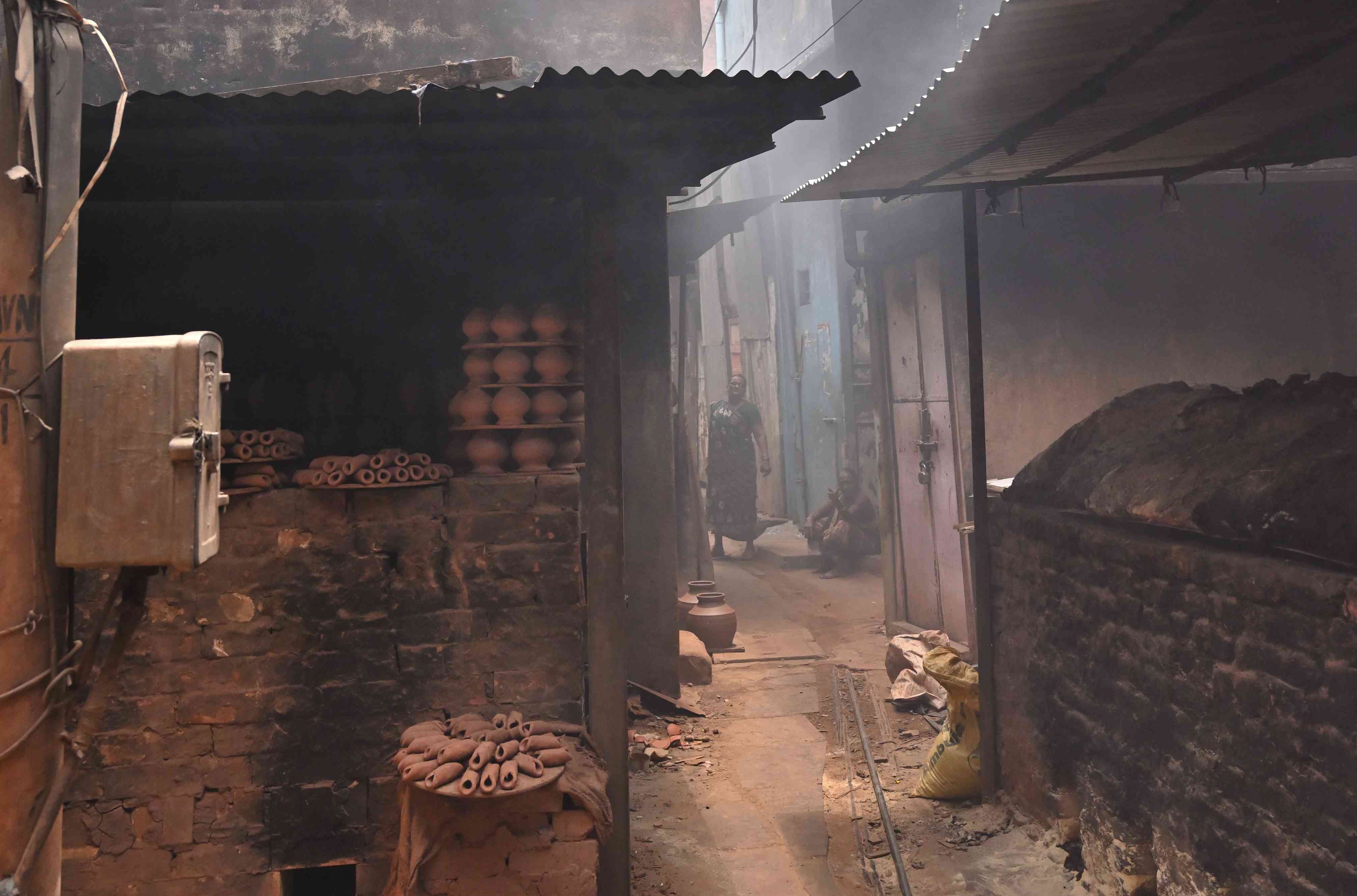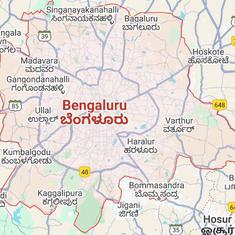Twenty years ago, Nafees Khan travelled 1,500 km from home in search of a job.
He found one in Mumbai’s Dharavi, the slum that is home to a large number of small manufacturing and processing units.
Today, Khan earns Rs 20,000 a month at a workshop that manufactures grinding machines. He sends most of his income back home to Pratapgarh, Uttar Pradesh. The workshop is also his shelter for the night.
Like Khan, thousands of migrant workers have made India’s largest slum their home over several decades.
But as the long-planned redevelopment of Dharavi picks up momentum, Khan’s future – and that of workers like him, who neither have ownership rights nor are tenants – looks uncertain.
Khan’s employer and owner of the unit, Shehzad Baig, said it is not just his workers who are worried about the redevelopment project. He is too.
“We don’t know if we will get a space to continue manufacturing or if we will be moved out,” Baig said. “Where will my workers sleep? They can’t afford rent.”
Baig’s workshop is in a section known as Tera Compound, a cluster of 13 parallel lanes in northwest Dharavi, into which are packed about 2,000 industrial and commercial units. Some handle scrap, some recycle plastic and automobile parts, others manufacture garments, cardboard, boxes, glass or machine parts.
With their fate uncertain, the workers and owners of Tera Compound have refused to allow their properties to be surveyed. “We are resisting because of the lack of communication from Adani and the government about our future,” said Liyaqat Ali, who owns a plastic recycling unit close to Baig’s.
The Adani Group holds an 80% stake in the project to develop the slum that sits in the geographical centre of Greater Mumbai.
A special purpose vehicle, Navbharat Mega Developers Private Limited, was formed between the Maharashtra government and the Adani Group to redevelop 251.4 hectares of the slum – an area as large as 150 cricket grounds. The project is estimated to cost of Rs 95,790 crore.
But with residents anxious about how they will fare in the new Dharavi, Adani officials are running into resistance as they attempt to survey the slum.
For example, surveyors have been refused entry into Tera Compound, Navbharat officials said.
Another section, located in the east of Dharavi, called Kumbharwada or potter’s colony, has also refused to participate in the redevelopment project, as have residents of Kamla Nagar in west of Dharavi, which houses leather manufacturing units. Also resisting are the owners of private land in a settlement in which large stretches are owned by public entities.
In all, 28.24 hectares has not been surveyed because of objections by residents.
“To survey the area, they need local cooperation. For that, they must gain public trust first,” said Shweta Damle, from Habitat and Livelihood Welfare Association, a non-profit that works for the shelter of the marginalised in Mumbai.
However, SVR Srinivas, the Indian Administrative Services officer who serves as the chief executive officer of Dharavi Redevelopment Project, told Scroll that nearly all commercial units and workshops will be accommodated in the redeveloped neighbourhood.

The terms of redevelopment
In its masterplan, Navbharat Developers said it plans to resettle 2.92 lakh people. However, the plan does not mention the type of rehabilitation that could be offered to ineligible commercial and industrial units.
According to the government’s eligibility cut-off, only commercial units on the ground floor who settled before January 1, 2000, are considered eligible and will be rehabilitated for free. They are likely to receive a 225 square feet of commercial space. Those on upper floors are ineligible even if they had set up business before 2000.
“A huge number of industrial units will be considered ineligible due to this clause,” said Ansar Ahmed Shaikh, the president of Dharavi Businessmen Welfare Association, which has over 1,000 members. Shaikh pointed out a source of anxiety for business owners – it is not clear if the factories that operate on large plots will be compensated with a similar-sized piece of land or the standard 225-sq-ft space.
However, Srinivas of the Dharavi Redevelopment Project told Scroll that they “are trying to accommodate all the commercial and industrial units within Dharavi after redevelopment”.
“[Even] ineligible commercial and industrial units will be provided a space at highly subsidised rates or rental basis within Dharavi,” Srinivas said.
For residents, those living on ground-floor units before January 1, 2000, will be considered eligible for free rehabilitation within Dharavi. They are likely to get flats of 350 square feet. Those who settled between 2000 and 2011 will be considered ineligible but will be provided subsidised housing outside Dharavi. Those who settled between 2011 and 2022 – also ineligible – will be given rental housing options outside Dharavi.
Navbharat Developers plans to build 49,832 residential rehabilitation units for slum dwellers living in hutments, another 8,700 residential renewal units meant for those rehabilitated in buildings by government within Dharavi, and an approximate 13,468 industrial and commercial units.
It estimates there are over 20,000 industrial and commercial units in the slum.
Damle, from Habitat and Livelihood Welfare association, said Navbharat Developers’ estimate of Dharavi’s population was likely to be inaccurate. “These estimates are largely based on an old survey by MASHAL,” said Damle.
MASHAL or Maharashtra Social Housing and Action League, was a NGO appointment by the government to map Dharavi in September 2007. The survey estimated a population of four lakh residents. It was incomplete and locals now estimate a population of 8 lakh-10 lakh residents.
“The slum’s situation is different now,” Damle said. “The population has grown.”
The final count of people to be rehabilitated within the new Dharavi will change as the survey proceeds but these estimates indicate that nearly 6 lakh to 7 lakh residents could be labelled ineligible and may be forced out of Dharavi.
If that happens, it will be the largest urban exodus from a slum in India, said urban researcher Hussain Indorewala.
Ahmed Shaikh of the Dharavi Businessmen Welfare Association claimed that his forefathers had settled in the area in the 19th century, when it was still a swamp. Generations of his family have witnessed the transformation of the marshy land into the modern-day slum that it is, he told Scroll.
“We made Dharavi,” said Shaikh. “People from across India made Dharavi their home. Now they face the threat of eviction if proven ineligible.”
Indorewala said the redevelopment is “really not for residents”.
“The whole scheme is a real estate development plan,” he said. “The fact that they are moving out families means that they want to clear land for the developer. This is prime real estate land near BKC”, the upmarket Bandra Kurla Complex commercial district.
Several families told Scroll they had been receiving threats for resisting eviction, a claim echoed by Congress MP from Dharavi, Varsha Gaikwad. Anwar Min, a potter in Kumbharwada, said officials have “subtly threatened” them that they would be forcibly removed if they opposed the redevelopment plan.
In some areas where residents may have not participated in the survey, drones have been used to map structures.
In a recent interview with The Times of India, Srinivas had said that the project does not require the approval of residents because the developer has been appointed by the state government and more than 50% people had already agreed to the plan.
But Srinivas told Scroll that they have been holding numerous meetings with local businesses, specifically those in Tera Compound with and the potters of Kumbharwada, to resolve their doubts.
“Ten per cent of the total built-up area will be commercial,” he said. “We are trying to strike a win-win deal but we cannot make everyone happy.”
Queries emailed to Adani went unanswered.

A business hub
In Tera Compound, overhead electric wires hung low over the narrow lanes that workers used to access the dingy workshops and warehouses.
Not far from Shehzad Baig’s workshop, Gautam Jain runs a hardware store in Banwari Compound, the last lane of Tera Compound. His father began the business in 1980.
They have a shop on the ground floor and a storage unit on the first floor.
But his family, like Baig’s, does not technically own the plot on which the shop stands. Jain’s father was issued a “photo pass” four decades ago by the Brihanmumbai Municipal Corporation which owns large parcels of land in Dharavi along with Maharashtra Housing And Area Development Authority.
The photo pass is a legal document that gives slum residents the right to live or run a business on a specific plot.
Most businesses in Dharavi have photo passes. Previously, they came in the form of tiny booklets but have since been converted into identity cards.
The photo pass is essential to establish the eligibility of a resident or business owner to benefit from a redevelopment project.
But despite having a photo pass, Jain remains unsure of what he will get. “There is no clarity on what happens to us,” he said. “Adani officials said everyone will get a standard space of 225 sq feet per shop. That is too small. We will have to shut our business.”
Jain is wary of the way the redevelopment discussions are headed. The government “should have created a body of representatives to discuss our demands”, he said. “Nothing of this sort happened. Why should we allow the survey to happen?”

A few steps away are Mohammed Khan’s two large workshops, one 1,600 sq feet and another 500 sq feet. He manufacture scardboard boxes and paper rolls. His business in Dharavi is 35 years old. He too has a photo pass,
“I want redevelopment. Who would want to live in so much dirt and congestion?” Khan said. “But there is no clear communication about what will happen to our business. Will they give [us] an equally big space here or ask us to move out? The government and Adani both need to be transparent.”
Khan has 15 workers on his payroll, all migrants from Uttar Pradesh. For their sake, he has resisted official surveys, although Adani officials have paid informal visits to see his unit. “But when I ask them about financial compensation or eligibility, I get no answers,” he said.
Shaikh, the president of Dharavi Businessmen Welfare Association, said 90% of structures in Tera Compound are recycling or processing units. “We have had five meetings with officials for not just Tera Compound but all industrial units,” he said. “They verbally agree to whatever demands we make but till date they have given us nothing in writing.”
Their demands include declaring all residents and industrial units eligible for the benefits of the redevelopment plan and fair compensation if the industrial units are moved out of Dharavi. Shaikh says the lack of written agreements with slum dwellers has eroded their faith in the project.
Navbharat Developers did not respond to Scroll’s queries on how it plans to rehabilitate these businesses. Describing Tera Compound as “India’s recycling machine”, Srinivas told Scroll that the project “will try to provide a common dumping space for all units”.
With regard to the recycling units, Srinivas said that for “segregation, collection and processing, work can be done in individual units”.
Srinivas added that more than 85% industrial and commercial units in Dharavi are less than 350 square feet. “We are giving them a better deal,” he claimed.
About 10% of the units, he said, are operating on larger spaces. “We will see about them,” he added.
Under the current government plans, Shaikh fears, both Gautam Jain and Mohammed Khan will not be compensated for losing their first-floor factory units.
For many, proving ownership may also be difficult. “Most poor don’t have proper documentation as proof,” Shaikh said.
For instance, in 2017 the Slum Rehabilitation Authority and the municipal corporation began to convert photo passes into identity cards. But several people still have old photo passes, which are no longer considered valid proof, Shaikh said.
“They may face hurdles in getting free housing within Dharavi,” he said.

But the loss, perhaps, will be heavier for private land owners. Aamir Khan’s family has owned a 34,000-square-foot plot in Dharavi since 1911. They have built a two-storeyed structure on it.
Khan has 25 tenants living on the ground and first floors. He runs a garment manufacturing unit in a part of the plot. He . “We have no clarity about what will happen to our first floor,” Khan told Scroll. “It will be a huge loss if it is considered ineligible.”
Khan and other private landowners have decided to prevent any surveys of their premises until the government negotiates with them. Srinivas said they will fix a rate and acquire these private plots.
Members of the Dharavi Bachao Andolan, a collective representing the demands of the slum’s residents, estimate that more than 50% of the area’s population will be pushed out.
The six rehabilitation sites chosen by the Maharashtra government for Dharavi residents have only led to more anxiety.
Only one – the smallest – lies within a 10-km distance from Dharavi. The farthest rehabilitation plot in Aksa – the largest, where most of the population will be rehabilitated – is 28 km away. “We don’t want to go that far,” said Nasirul Haque, a resident and member of the Dharavi Bachao Andolan.
Most people also vehemently opposed being moved to the Deonar dumping ground, which has been selected as a rehabilitation site, said Haque.
The potters
For hundreds of families spread across five hectares of land in Kumbharwada, east of Dharavi, redevelopment poses a different set of challenges.
The colony of potters from Gujarat settled in 1887 along the Mithi river in Dharavi to make use of the soft mud from the river bed. In 1933, the British government allotted 360 potters a vacant land tenancy, which permitted long-term occupation though it did not give them land ownership.
Over the last 90 years, though the Mithi river has turned into a fetid drain, business in Kumbharwada has grown and families have multiplied.
They now source clay from Gujarat to make earthen pots, artefacts and diyas. These are exported across the world. “Entire families get involved in the process of pottery,” said Ranchod Chauhan, former president of Prajapati Society Udpadak Mandal.
The workers sieve the clay, then knead, shape and lay it out to dry. The products are baked in a brick-fired kiln and then painted.
“Machines have reduced the space we need for production, but we still need open space to dry the pots,” said Anwar Min, who has a large family lives and works on a 2,000-sq-ft plot. Most structures here have pottery workshops on the ground floor and living quarters on the upper floors.
Since upper floors are considered illegal and therefore ineligible under the Dharavi plan, Min will lose out on at least 4,000 sq ft of space. He is even unsure if he will receive the 2,000 sq ft of ground-floor space he currently occupies.
Adam Jala, who heads the Potter Welfare Association, said residents of Kumbharwada do not want to move their homes or their business out of Dharavi. “If the business moves out, it will be the end of Kumbharwada,” he said.

Samya Korde, an activist from Dharavi Bachao Andolan, said that earlier, Kumbharwada had not been a part of the Dharavi redevelopment plan. “It has been added to the notified area recently,” Korde said.
Another pressing issue is the pollution from the brick kilns. The government does not want to place them close to redeveloped buildings.
Potter Vijay Waghela said they had held meetings with Srinivas, the CEO of Dharavi Redevelopment, but “we faced threats of eviction when we said that we do not want to be a part of Dharavi redevelopment”.
Srinivas told Scroll that the authorities “are trying” to resettle the potters within Dharavi, not exactly where they currently live but a little distance away.
“We are considering the nature of their work,” he said. “They need a drying area, a brick kiln... we will make provisions for that. Perhaps they can have one common brick kiln.”
But Waghela said they feared that they would be forced to leave. “This is a matter of our homes,” he said. “We can’t let them take that away.”










